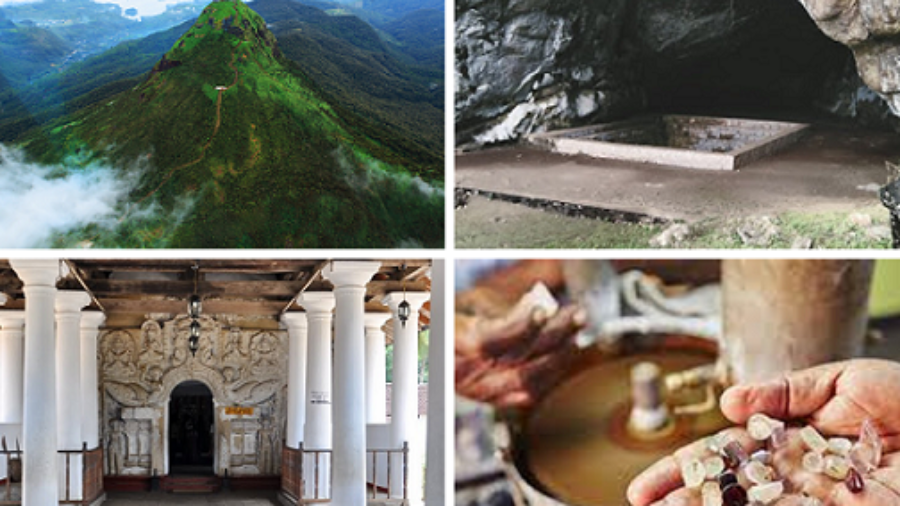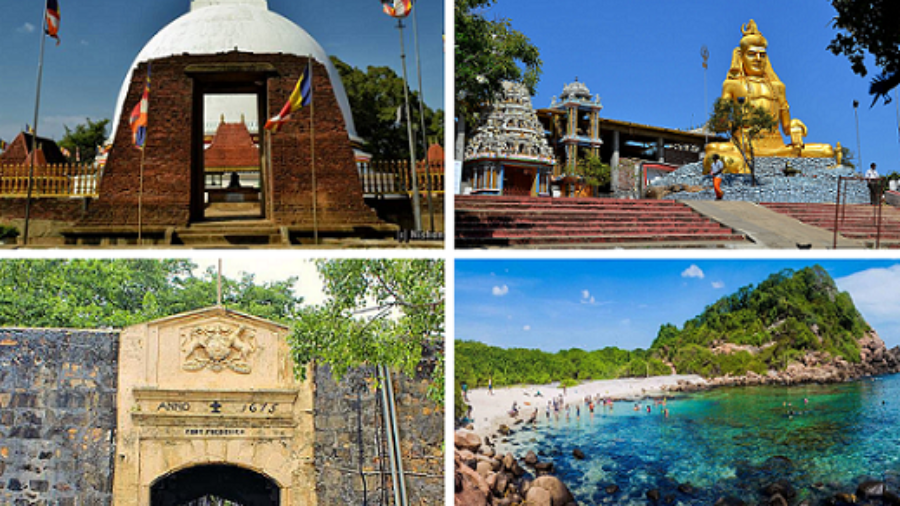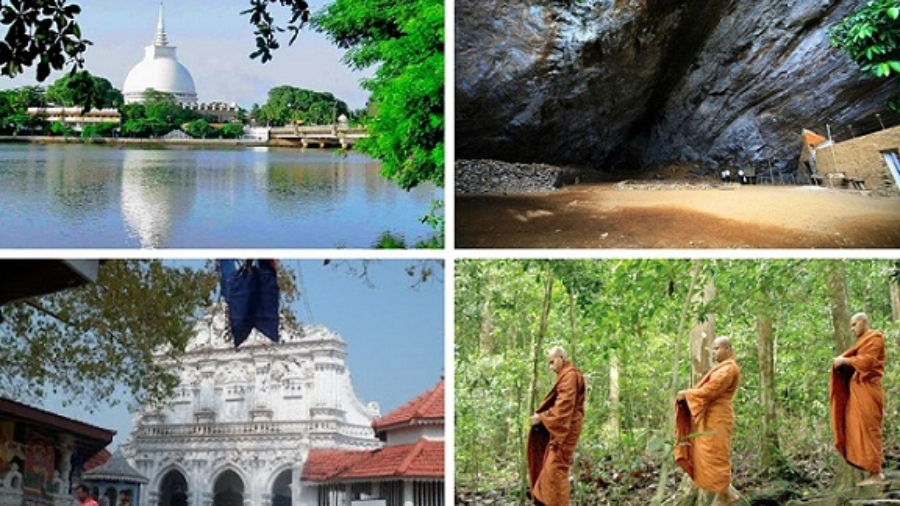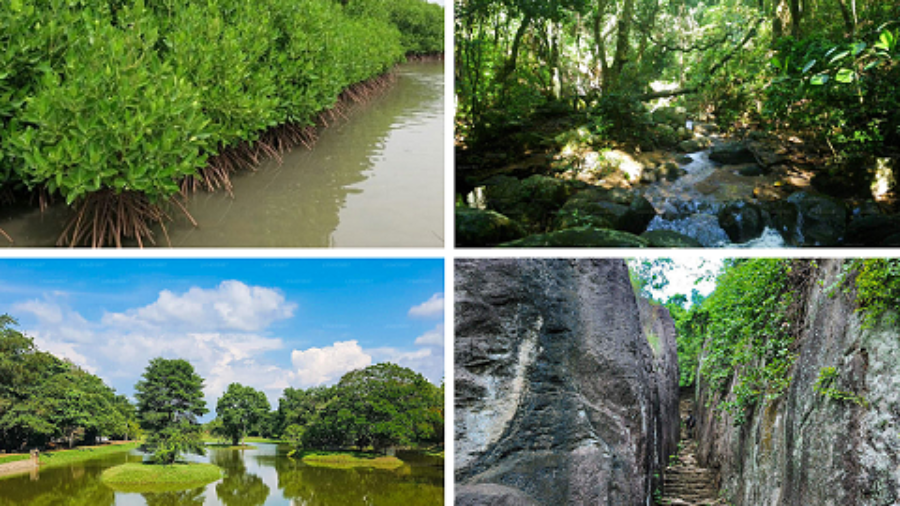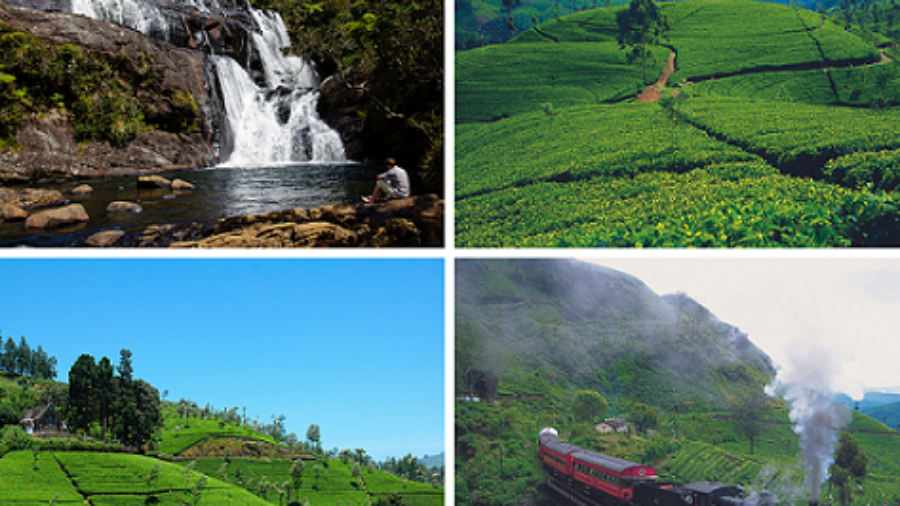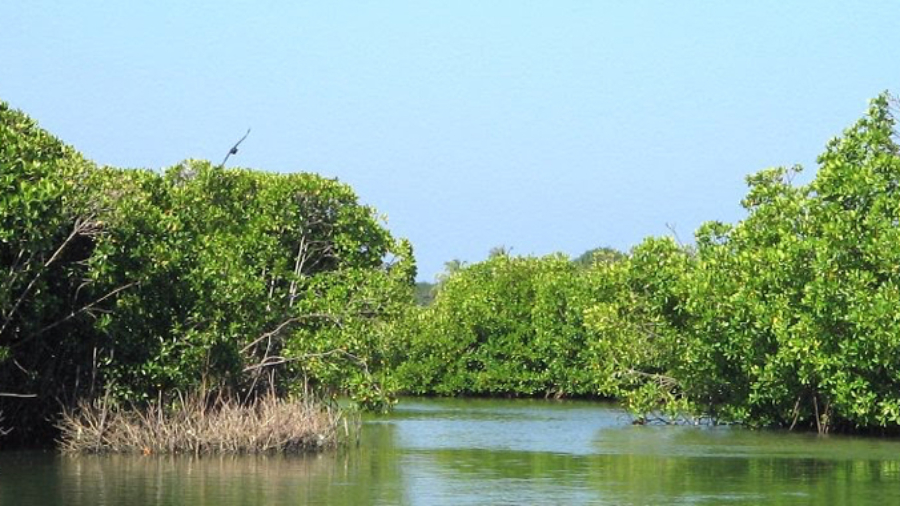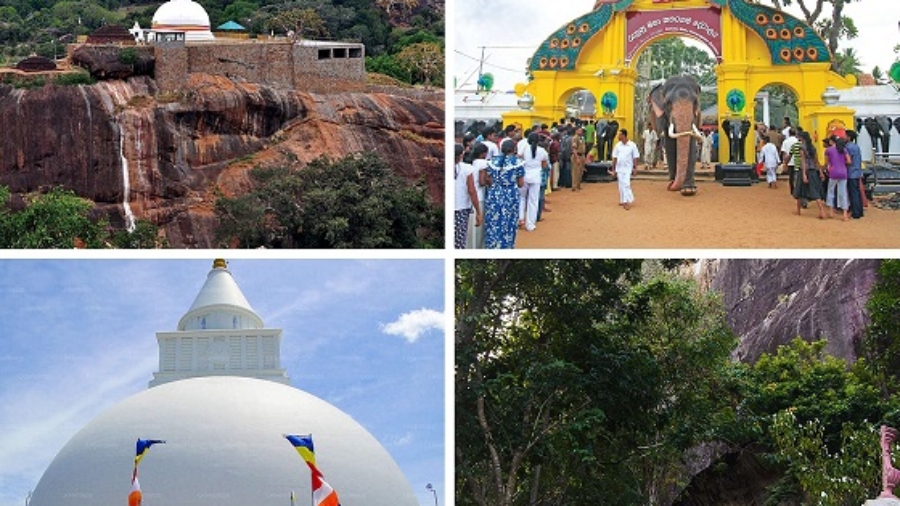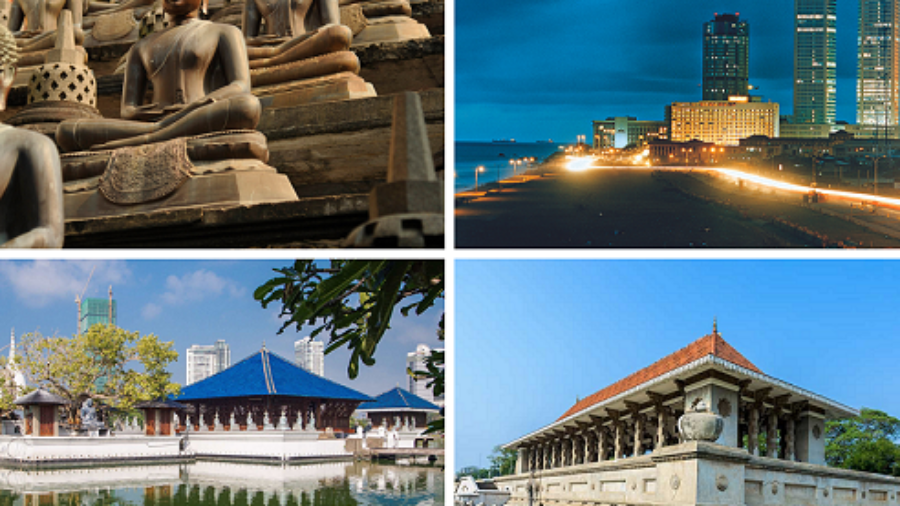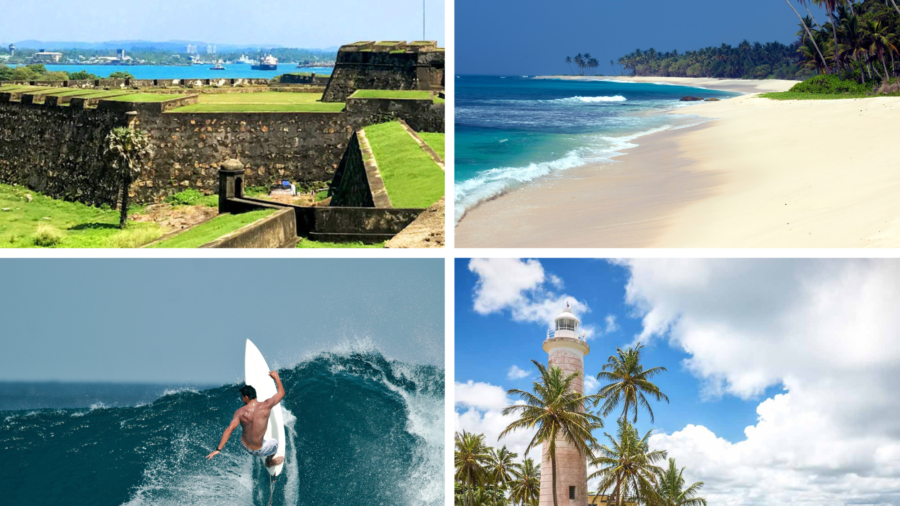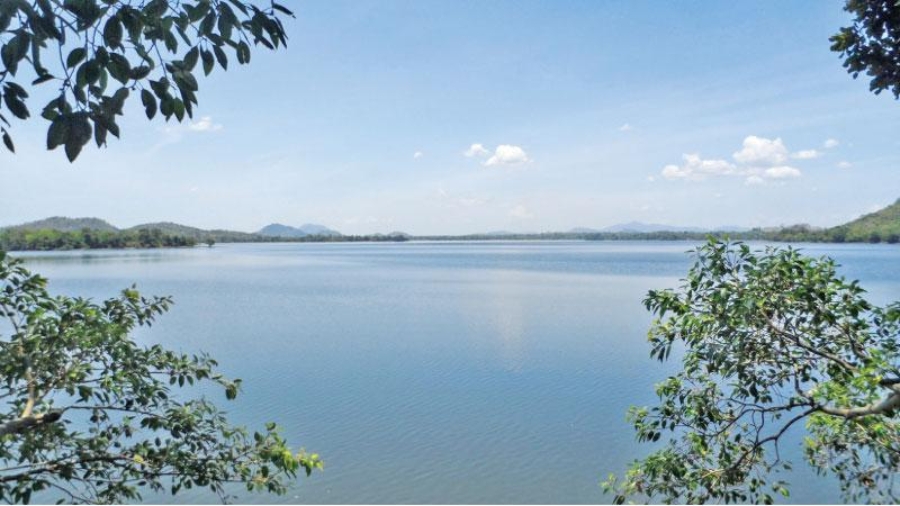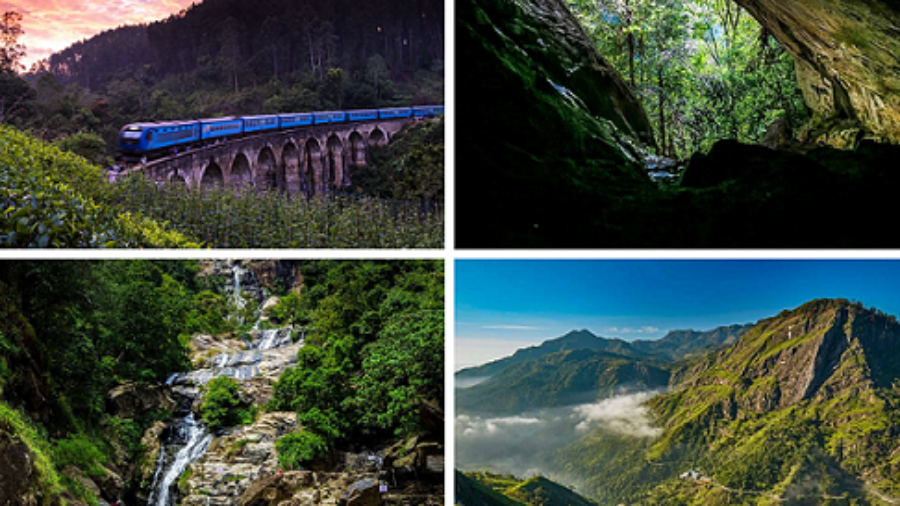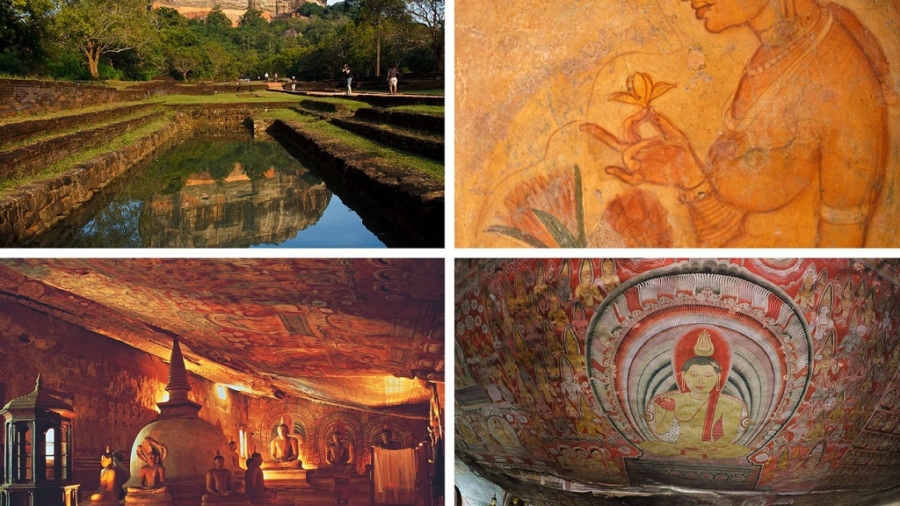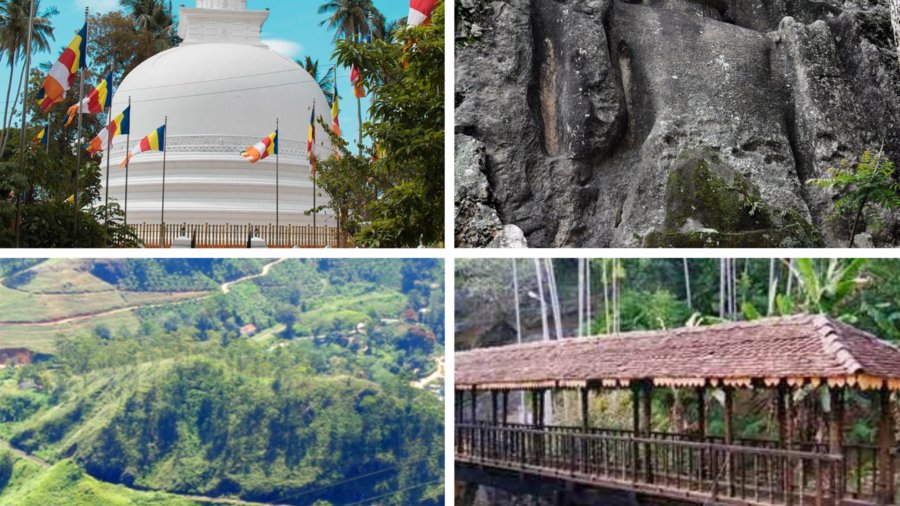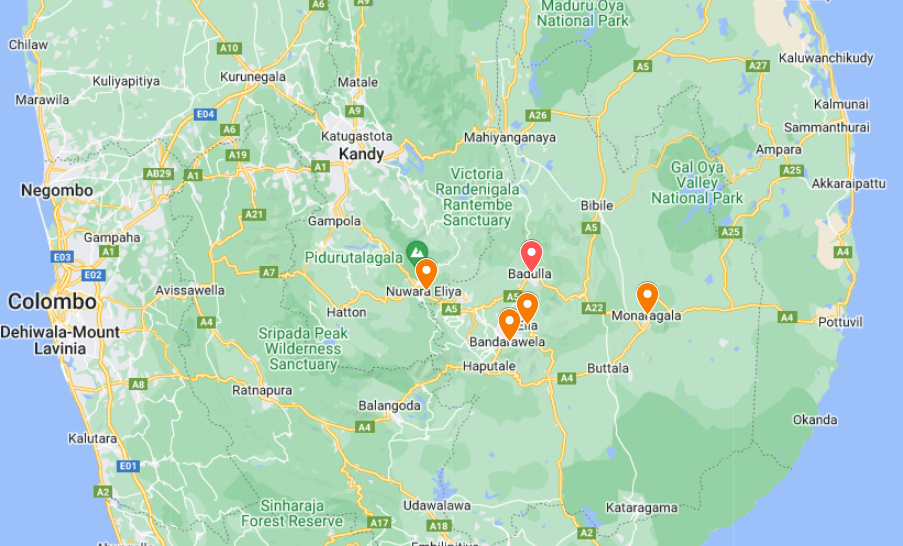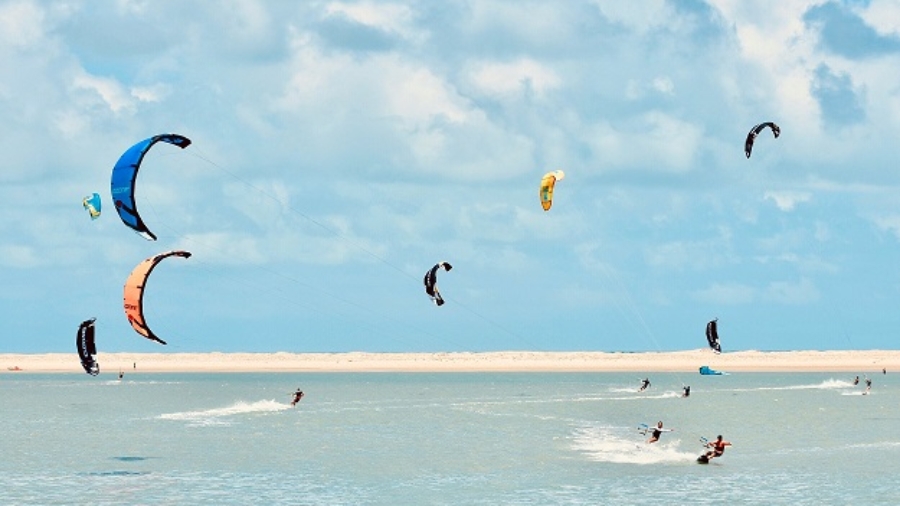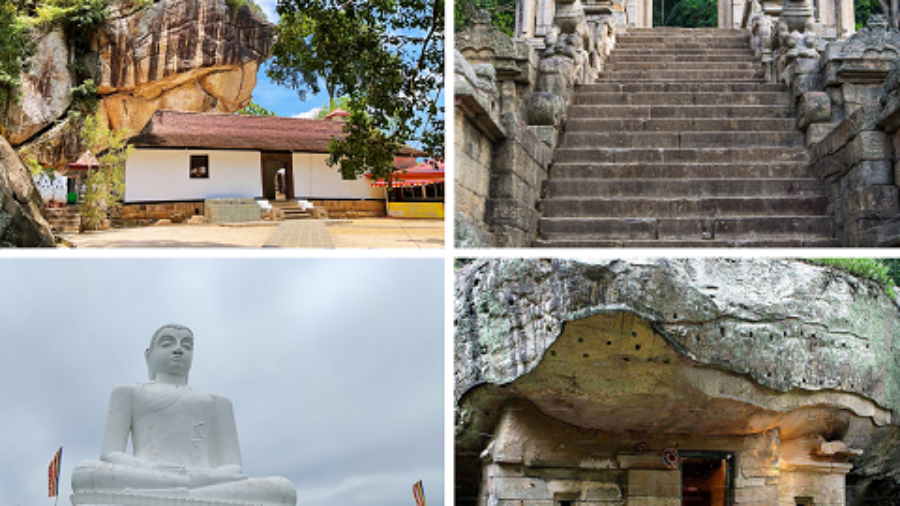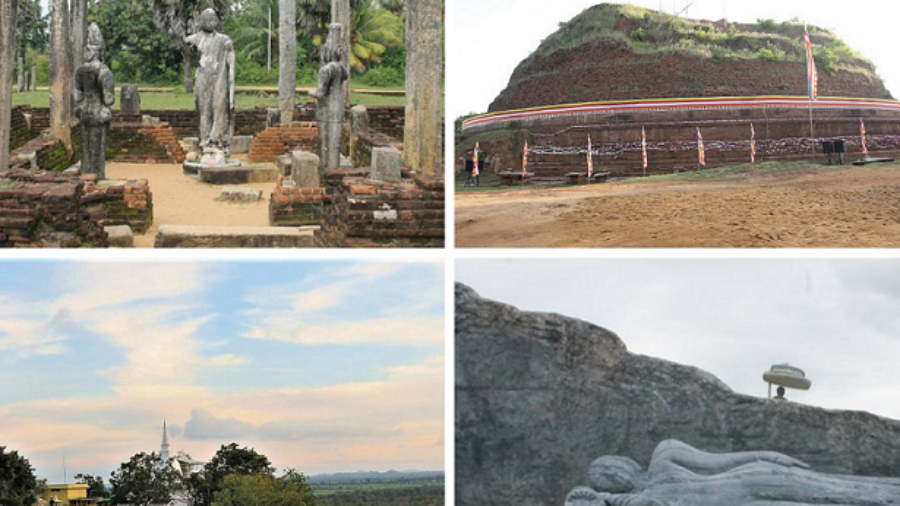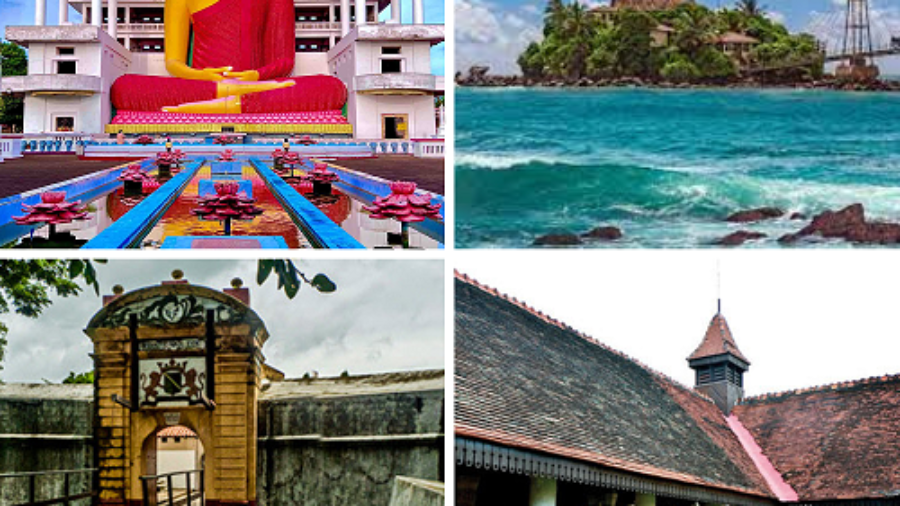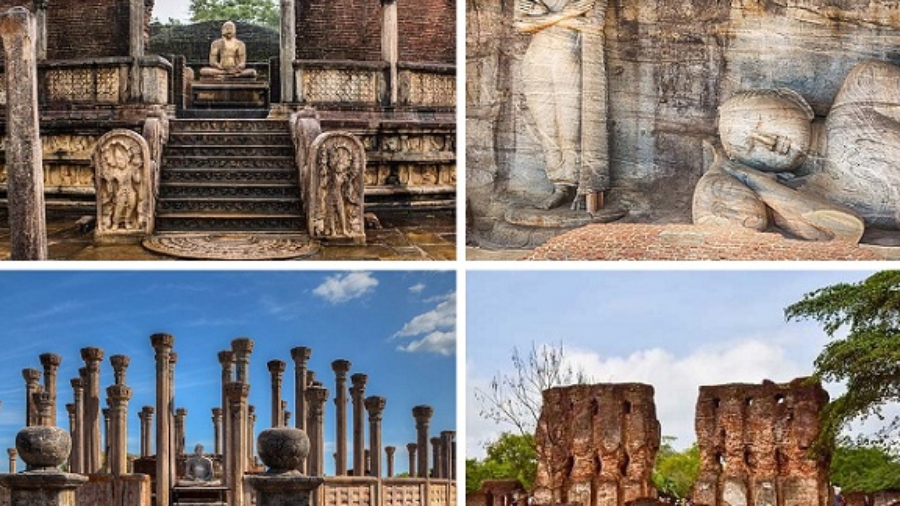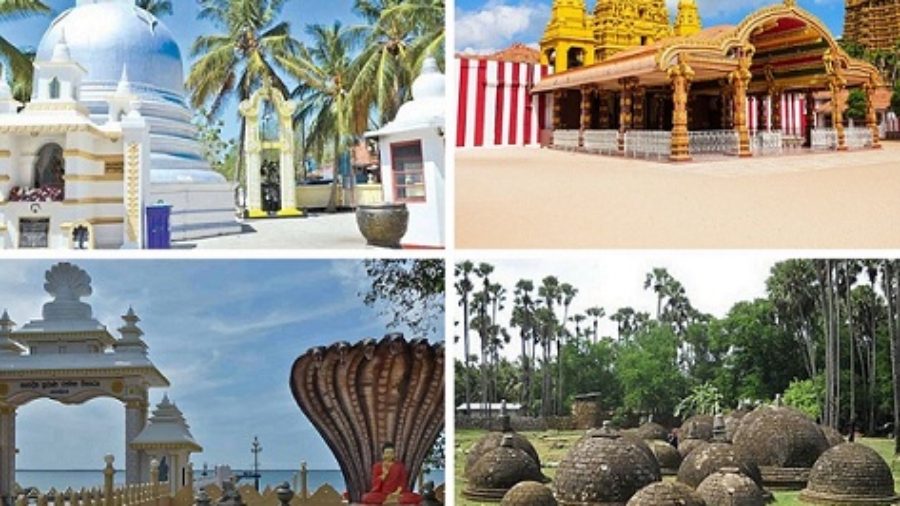Ratnapura, known as the “City of Gems,” is a captivating tourist attraction nestled in the heart of Sri Lanka. Renowned for its gem mines and gemstone trade, Ratnapura offers a fascinating glimpse into the world of precious stones. Visitors can explore bustling gem markets, witness gem cutting and polishing processes, and even try their luck at gemstone mining. Apart from its gem-related attractions, Ratnapura also boasts picturesque landscapes, cascading waterfalls, and lush greenery. The surrounding rainforests and nature reserves provide opportunities for adventurous activities like trekking and wildlife spotting. The city is also home to ancient temples and historical sites, such as the Maha Saman Devalaya and the historic Katugas Ella Foot Bridge. With its unique blend of natural beauty, cultural heritage, and gemstone treasures, Ratnapura is a must-visit destination for tourists seeking an authentic Sri Lankan experience.
Culture and Archeological Interest of Ratnapura
Ratnapura is a city renowned for its rich cultural heritage and archaeological significance.Ratnapura is often referred to as the “City of Gems” due to its abundant gem deposits. It has a long history of gem mining and is famous for producing some of the world’s finest gemstones, including sapphires, rubies, and cat’s-eye. Ratnapura and its surrounding areas are home to several archaeological sites that provide insights into the region’s ancient history.As a example
Ratnapura is a city renowned for its rich cultural heritage and archaeological significance.Ratnapura is often referred to as the “City of Gems” due to its abundant gem deposits. It has a long history of gem mining and is famous for producing some of the world’s finest gemstones, including sapphires, rubies, and cat’s-eye. Ratnapura and its surrounding areas are home to several archaeological sites that provide insights into the region’s ancient history. As a example The Balangoda archaeological complex, Pahiyangala Cave etc. Saman Devalaya is a significant pilgrimage site for Buddhists and Hindus alike, attracting devotees from all over the country during religious festivals.
Overall, Ratnapura’s cultural heritage, gemstone industry, archaeological sites, traditional crafts, and natural beauty make it a fascinating destination for those interested in exploring Sri Lanka’s history and culture.
Maha Saman Devalaya
Importance and History: Maha Saman Devalaya holds great importance for both Buddhists and Hindus in Sri Lanka. The temple is believed to have been established in ancient times, and it has been a place of worship for centuries. The deity Saman is revered as a guardian and protector of the country, and his worship is believed to bring blessings and prosperity.
Religious Significance: Devotees from various parts of the country visit Maha Saman Devalaya to seek the blessings of Saman. It is believed that the deity has the power to fulfill the wishes and provide protection to his devotees. The temple is especially popular during the annual Esala Perahera, a grand procession held in honor of Saman, which attracts a large number of pilgrims.
Esala Perahera: It takes place in the month of July or August and lasts for several days. The festival features vibrant processions with traditional dancers, drummers, and elephants adorned with elaborate costumes. The sacred tooth relic of Saman is carried in a beautifully decorated tusker during the procession.
Architecture and Features: Maha Saman Devalaya showcases traditional Sri Lankan architecture. The main shrine of the temple is adorned with intricate woodwork and carvings.
Maha Saman Devalaya is not only a place of religious worship but also an important cultural and historical site in Ratnapura. It provides a glimpse into the religious traditions and beliefs of the people of Sri Lanka and offers a serene and spiritually uplifting experience for visitors.
Gem Museum In Ratnapura
Ratnapura, being the “City of Gems,” is home to several gem museums that showcase the rich gemstone heritage of the region. One prominent gem museum in Ratnapura is the Ratnapura Gem Museum.
The Ratnapura Gem Museum is a renowned institution dedicated to educating visitors about the gemstone industry in Ratnapura and Sri Lanka as a whole. It serves as a showcase for the gemstones found in the region and provides insights into their mining, processing, and craftsmanship.
Exhibits and Collections: The museum houses a vast collection of gemstones, including sapphires, rubies, cat’s-eye, topaz, garnets, and more. These gemstones are displayed in various forms such as rough stones, polished gemstones, and exquisite jewelry pieces. The exhibits highlight the diverse colors, cuts, and qualities of the gemstones found in Ratnapura.
Educational Information: The Ratnapura Gem Museum offers informative displays, panels, and videos that explain the geological formation of gemstones, the process of gem mining, and the art of gemstone cutting and polishing. Visitors can learn about the different types of gemstones, their properties, and the factors that determine their value.
Visiting the Ratnapura Gem Museum is a great way to explore the gemstone heritage of the region, learn about the gemstone industry, and appreciate the beauty and craftsmanship associated with Sri Lankan gemstones. It offers an enriching experience for gem enthusiasts, jewelry lovers, and those interested in the cultural and economic significance of gemstones in Ratnapura.
Batadombalena
Batadombalena is an important archaeological site located in Kuruwita, Sri Lanka. It holds significant historical and archaeological value, providing insights into early human habitation on the island.
Archaeological Significance: The site gained prominence when a human skeleton was discovered in 1981. This discovery marked the first scientifically excavated skeletal remains of Homo sapiens balangodensis, commonly known as the Balangoda Man. The Balangoda Man is an ancient subspecies of Homo sapiens that lived in Sri Lanka approximately 38,000 years ago.
Excavations and Findings: Extensive excavations have been carried out at Batadombalena, unearthing numerous artifacts and evidence of early human activity. Stone tools, animal bones, and fragments of pottery have been discovered, shedding light on the lifestyles and behaviors of the Balangoda Man. The site also contains a cave, believed to have been used as a shelter by early humans.
Balangoda Man: The Balangoda Man is considered one of the oldest known human populations in Sri Lanka. The skeletal remains found at Batadombalena provide valuable information about the physical characteristics, cultural practices, and technological advancements of this early human population. These findings have contributed significantly to our understanding of prehistoric human settlements in Sri Lanka.
Research and Preservation: Batadombalena and its archaeological findings are of great interest to researchers, anthropologists, and archaeologists. Ongoing studies continue to deepen our knowledge of the Balangoda Man and the ancient history of Sri Lanka. Efforts are also being made to preserve and protect the site for future generations.
Visiting Batadombalena provides a unique opportunity to witness the archaeological remnants of early human civilization in Sri Lanka.
Natural Beauty and Adventure of Ratnapura
Ratnapura, known as the “City of Gems,” is not only rich in cultural and archaeological attractions but also offers abundant natural beauty and opportunities for adventure.
Ratnapura is surrounded by stunning landscapes characterized by lush greenery, rolling hills, and tea plantations. The area is known for its picturesque vistas, especially in the hill country regions surrounding Ratnapura. Traveling through the countryside offers breathtaking views and a chance to immerse yourself in the natural beauty of the region.Sinharaja Forest Reserve is a UNESCO World Heritage Site and a biodiversity hotspot. This pristine rainforest is home to a wide range of plant and animal species, including many endemic and endangered species. Nature lovers can explore the forest through guided hikes and witness the unique flora and fauna that thrive in this protected area.
While not exactly a natural attraction, Ratnapura’s gem mining industry can provide a unique adventure experience. Visitors can join guided tours to gem mines, where they can witness the traditional mining methods and try their luck at gemstone digging.
Whether you’re seeking natural beauty, adventure, or a combination of both, Ratnapura offers a range of experiences to satisfy your interests. From exploring waterfalls and rainforests to engaging in outdoor activities and learning about the gemstone industry, Ratnapura has something to offer for every nature lover and adventure seeker.
Adams Peak (Sri Padaya)
Adams Peak, also known as Sri Pada, is a significant pilgrimage site located in the Ratnapura District of Sri Lanka. It is a conical mountain peak standing at an elevation of 2,243 meters (7,359 feet) above sea level.
Spiritual Significance: Adams Peak holds religious importance for multiple faiths, including Buddhism, Hinduism, Islam, and Christianity. The peak is revered for the “Sri Pada” or “Sacred Footprint,” which is believed to be the footprint of Lord Buddha by Buddhists, Lord Shiva by Hindus, Adam by Muslims, and St. Thomas by Christians.
Pilgrimage Season: The pilgrimage season to Adams Peak typically begins in December and lasts until May, with the peak period being January to April. During this time, thousands of devotees, both locals and tourists, embark on the challenging climb to pay homage to the Sacred Footprint and experience the spiritual atmosphere.
The Climb: The ascent to Adams Peak involves climbing a series of steep steps, approximately 5,500 in total, which have been constructed along the route. The traditional starting point is the town of Nallathanniya, where pilgrims gather before commencing their journey. The climb can be physically demanding but is achievable by individuals of varying fitness levels.
Sunrise View: One of the most spectacular experiences at Adams Peak is witnessing the sunrise from the summit. Many pilgrims start their climb in the early hours of the morning to reach the top in time for sunrise. The breathtaking panoramic views of the surrounding mountains, clouds, and mist as the sun rises make for a memorable and spiritual experience.
Teahouses and Resting Points: Along the trail, there are several teahouses and resting points where climbers can take a break, enjoy a warm cup of tea, and refuel before continuing their ascent. These pitstops provide a chance to interact with fellow climbers and experience the local hospitality.
Bell-Ringing and Offering Rituals: At the summit, there is a small shrine housing the Sacred Footprint. Devotees ring a bell and offer prayers and flowers as a mark of reverence. It is a moment of reflection and spiritual connection for pilgrims.
Wildlife and Natural Beauty: Adams Peak is nestled within the Peak Wilderness Sanctuary, a protected area known for its rich biodiversity. The climb offers glimpses of this natural beauty and an opportunity to appreciate the serene environment.
Sinharaja Forest Reserve
The Sinharaja Forest Reserve is a renowned UNESCO World Heritage Site located in the southwest of Sri Lanka, spanning across the districts of Ratnapura, Galle, and Matara.
Biodiversity Hotspot: Sinharaja Forest Reserve is considered a biodiversity hotspot and is one of the last remaining primary tropical rainforests in Sri Lanka. It is home to an incredible array of flora and fauna, including numerous endemic species. The forest is renowned for its high species richness and endemism, making it a valuable ecological treasure.
Flora: Sinharaja Forest Reserve boasts a diverse range of plant species, including towering trees, colorful orchids, endemic ferns, and medicinal plants. The forest is characterized by its dense canopy, which allows limited sunlight to penetrate the forest floor, creating a unique and enchanting ecosystem.
Fauna: The forest reserve is teeming with wildlife, including rare and endemic species. It is home to 26 endemic bird species, including the Sri Lanka blue magpie, Sri Lanka junglefowl, and red-faced malkoha. Sinharaja also houses several mammal species such as the purple-faced langur, Sri Lankan leopard, and endemic purple-faced leaf monkey. Reptiles, amphibians, and insects also thrive within the forest’s boundaries.
Trekking and Nature Trails: The Sinharaja Forest Reserve offers a network of well-maintained trekking and nature trails that allow visitors to explore its pristine beauty. The trails vary in length and difficulty, providing options for both casual hikers and more adventurous trekkers. Experienced guides are available to lead visitors and provide information about the forest’s ecology and wildlife.
Birdwatching: The forest reserve is a paradise for birdwatchers, offering exceptional opportunities to spot rare and endemic bird species. The early morning hours are especially rewarding for birdwatching, as the forest comes alive with the sounds of various avian species. The diversity of birdlife makes Sinharaja a favorite destination for bird enthusiasts and ornithologists.
Research and Conservation: Sinharaja Forest Reserve has been the subject of extensive scientific research due to its ecological significance. Researchers and conservationists continue to study and monitor the forest’s unique biodiversity to ensure its long-term conservation. Efforts are made to raise awareness about the importance of preserving this fragile ecosystem.
Kitulgala
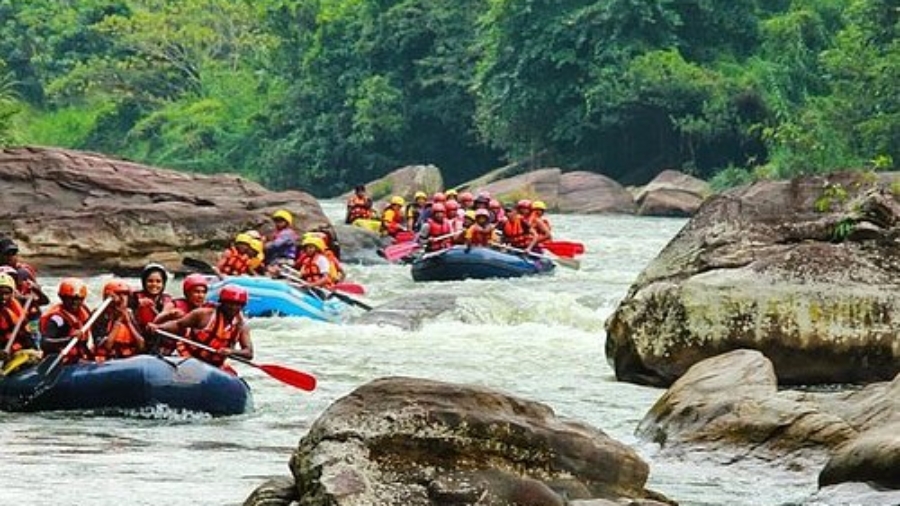
Kitulgala is a small town located in the Kegalle District of Sri Lanka, approximately 90 kilometers northeast of Colombo.
Natural Beauty: Kitulgala is nestled amidst lush greenery and is surrounded by the verdant forests of the Kelani River Valley. The picturesque landscapes, with the Kelani River flowing through the town, create a serene and idyllic atmosphere. The area’s abundant flora and fauna contribute to its natural beauty.
Adventure Sports and Activities: Kitulgala is famous for its adventure sports and outdoor activities, attracting thrill-seekers and nature enthusiasts. Some popular activities include white-water rafting, where you can navigate the rapids of the Kelani River, providing an adrenaline-pumping experience. Canyoning, trekking, hiking, and waterfall jumps are also available for those seeking adventure.
Film Location: Kitulgala gained international recognition as the filming location for the iconic movie “The Bridge on the River Kwai” in 1957. The bridge constructed for the film still stands today and is a tourist attraction. It offers a glimpse into the area’s cinematic history and provides a picturesque spot for photography.
Rainforest Exploration: The nearby rainforests offer opportunities for nature walks and exploration. You can discover the diverse flora and fauna, including endemic bird species and colorful butterflies. Guided tours are available to provide insights into the forest ecosystem and its importance for conservation.
Waterfall Visits: Kitulgala is home to several stunning waterfalls that are worth a visit. The nearby Kadiyanlena Falls, located in the Kelani River Valley, is a popular spot for picnics and nature appreciation. The falls offer a refreshing cascade of water amidst the greenery, creating a tranquil setting.
Birdwatching: The region around Kitulgala is a paradise for birdwatching enthusiasts. The area is known for its diverse avian species, including many endemic and migratory birds. The surrounding forests and riverbanks provide excellent opportunities to spot and photograph various bird species.
Kitulgala is a haven for adventure seekers, nature lovers, and those looking to escape the bustling city life. Its stunning natural landscapes, thrilling activities, and opportunities for outdoor exploration make it an appealing destination for both local and international travelers.
Boptah Ella Falls
Bopath Ella Falls is a beautiful waterfall located in the Ratnapura District of Sri Lanka. It is situated in the village of Agalawatta, approximately 13 kilometers northeast of Ratnapura town.
Natural Beauty: Bopath Ella Falls is known for its natural beauty and is a popular tourist attraction in the area. The waterfall cascades down from a height of approximately 30 meters (98 feet) into a large pool at the base, creating a picturesque setting. The lush greenery surrounding the falls adds to its charm.
Legend and Name: The name “Bopath Ella” is derived from the Sinhala language, with “Bo” meaning “Bo” tree and “path” meaning “pathway.” According to local folklore, the shape of the waterfall resembles the leaf of the sacred Bo tree, which is significant to Buddhists in Sri Lanka.
Picnic Spot: The area around Bopath Ella Falls provides a serene and picturesque setting, making it a popular spot for picnics. Visitors can relax by the pool or on the grassy banks while enjoying the natural beauty and the soothing sound of the cascading water.
Visiting Bopath Ella Falls allows you to experience the natural splendor of Sri Lanka and enjoy a peaceful and refreshing retreat in the midst of nature. The tranquil atmosphere, scenic surroundings, and the legend associated with the falls make it a worthwhile destination for nature lovers, photographers, and those seeking a serene getaway.
Bambarakanda Waterfalls
Height and Location: Bambarakanda Falls stands at an impressive height of approximately 263 meters (863 feet), making it the tallest waterfall in Sri Lanka. It is located in the Badulla District, near the village of Kalupahana, which is about 18 kilometers from Haputale.
Natural Beauty: The waterfall is set amidst the verdant hills of the Horton Plains and offers breathtaking views of cascading water against a backdrop of lush greenery. The area surrounding Bambarakanda Falls is characterized by tea plantations, rugged landscapes, and mist-covered mountains, creating a picturesque setting.
Accessibility: The falls can be reached by a short hike from the main road. A trail leads through scenic landscapes, passing tea estates and forests, until you reach the viewpoint from where you can admire the majestic waterfall. The hike is relatively easy and suitable for most visitors.
Swimming and Bathing: The base pool of Bambarakanda Falls provides a refreshing spot for swimming and bathing. The crystal-clear water cascading down creates a natural pool where visitors can cool off and enjoy the serene environment. However, it is important to exercise caution and be aware of the current and water conditions.
Trekking and Hiking: The area around Bambarakanda Falls offers opportunities for trekking and hiking enthusiasts. There are various trails and routes that allow you to explore the surrounding landscapes, including the nearby Horton Plains National Park and the Kirigalpoththa Peak, which is the second highest mountain in Sri Lanka.
Nearby Attractions: While visiting Bambarakanda Falls, you can also explore other nearby attractions, such as the Horton Plains National Park, World’s End viewpoint, and the Ohiya Gap. These locations offer stunning views, unique flora and fauna, and opportunities for wildlife sightings.
Katugas Ella Waterfalls
Katugas Ella Waterfall is situated in the Ratnapura District of Sri Lanka, surrounded by lush greenery and natural beauty. The waterfall flows gracefully down a series of rocky steps, forming multiple tiers that add to its visual appeal.
Height and Spray: The water descends from a considerable height, creating a stunning sight as it forms a white foamy spray before gently settling into a crystal-clear pool at the base.
Pool: The pool at the bottom of the waterfall is an inviting oasis, with emerald-green water that offers a refreshing respite from the tropical heat. Visitors can take a dip and feel the invigorating rush of the waterfall on their skin.
Scenic Surroundings: The waterfall is surrounded by dense foliage, including towering trees, swaying palms, and vibrant flowers, which enhance its visual beauty. The lush greenery provides shade and a cool ambiance, making it an ideal spot for relaxation.
Trekking Trail: To reach Katugas Ella Waterfall, visitors may need to traverse a short trek through the verdant forest. The well-marked trail offers glimpses of exotic flora and fauna, such as butterflies and birds, adding to the enchantment of the journey.
Picnic Spot: The picturesque landscape around the waterfall is perfect for picnics. Visitors can sit on the surrounding rocks, enjoy the misty spray, and immerse themselves in the tranquility of the surroundings.
Nature Photography: Katugas Ella Waterfall provides ample opportunities for nature photography. The cascading water, lush greenery, and vibrant surroundings create stunning backdrops for capturing memorable moments.
Serene Ambiance: The overall ambiance of Katugas Ella Waterfall is serene and peaceful, making it an ideal destination for those seeking solace in nature and a break from the hustle and bustle of daily life.
Katugas Ella Waterfall offers a memorable experience for nature lovers, adventure enthusiasts, and anyone looking to explore the natural beauty of Ratnapura. It’s a must-visit destination that showcases the captivating wonders of Sri Lanka’s waterfalls.
